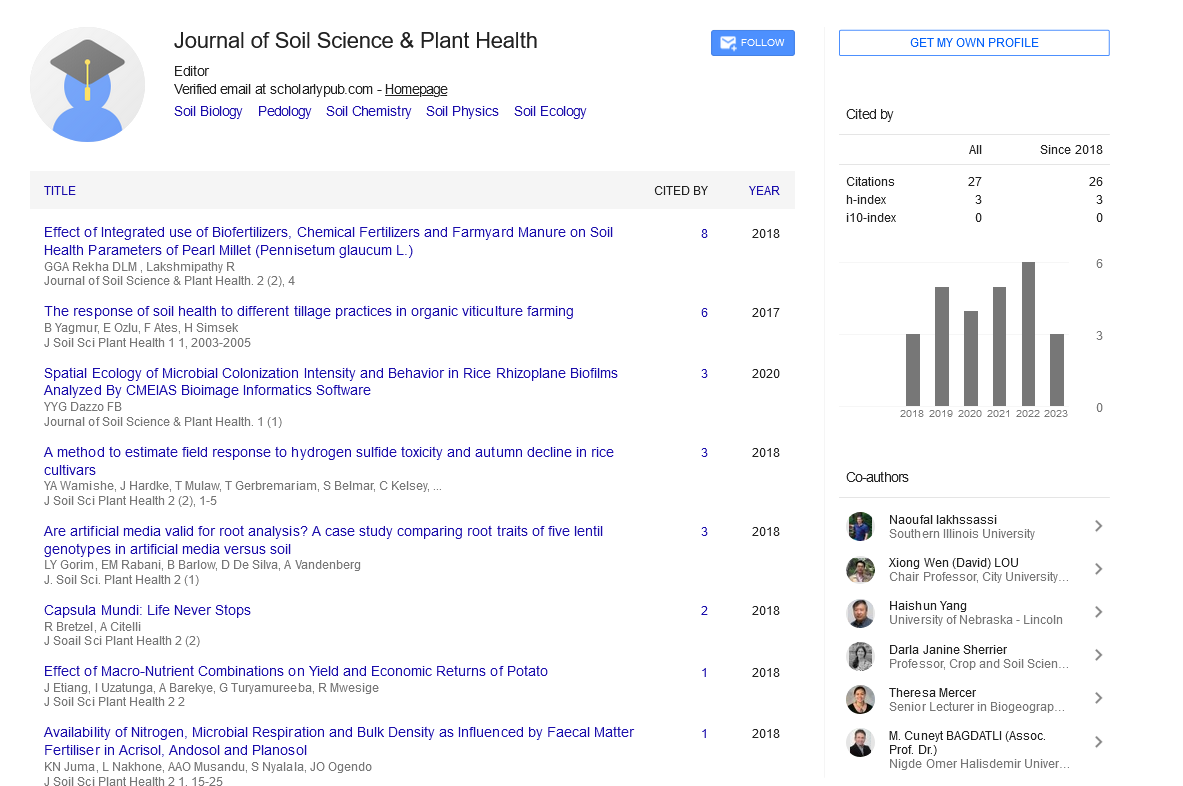Editorial, J Soil Sci Plant Health Vol: -7 Issue: -1
Microbe-Enhanced Nutrient Uptake: A Natural Path to Sustainable Agriculture
Giovanni Martinotti*
Department of Microbial Ecology, University of Bologna, Italy
- *Corresponding Author:
- Giovanni Martinotti
Department of Microbial Ecology, University of Bologna, Italy
E-mail: mari756@gmail.com
Received: 01-Feb-2025, Manuscript No. Jsph-25-170159; Editor assigned: 4-Feb-2025, Pre-QC No. Jsph-25-170159 (PQ); Reviewed: 18-Feb-2025, QC No. Jsph-25-170159; Revised: 25-Feb-2025, Manuscript No. Jsph-25- 170159 (R); Published: 28-Feb-2025, DOI: 10.4172/jsph.1000204
Citation: Giovanni M (2025) Microbe-Enhanced Nutrient Uptake: A Natural Path to Sustainable Agriculture. J Soil Sci Plant Health 7: 204
Introduction
As global agriculture strives for greater sustainability, scientists and farmers are increasingly turning to nature-based solutions. One such approach is Microbe-Enhanced Nutrient Uptake, which uses beneficial soil microorganisms to improve the efficiency of nutrient absorption by plants. This method not only reduces the dependence on chemical fertilizers but also promotes healthier soils and more resilient crops [1]. By fostering symbiotic relationships between plants and microbes, agriculture can become more productive, sustainable, and environmentally friendly [2].
Discussion
Soil microbes play a crucial role in the natural nutrient cycles of ecosystems. In particular, mycorrhizal fungi and plant growth-promoting rhizobacteria (PGPR) are known for their ability to improve plant nutrient uptake. These microbes colonize plant roots and extend their influence into the soil, breaking down complex minerals and organic matter into forms that plants can absorb [3].
Mycorrhizal fungi form symbiotic associations with plant roots, increasing the root surface area through their hyphal networks. This extension allows plants to access nutrients like phosphorus, zinc, and copper that would otherwise remain unavailable in the soil. In exchange, the fungi receive carbohydrates produced by the plant during photosynthesis [4].
Similarly, PGPR—such as species of Azospirillum, Rhizobium, and Bacillus—enhance nutrient uptake by fixing atmospheric nitrogen, solubilizing phosphorus, and producing plant hormones like auxins and cytokinins. These processes stimulate root growth and improve the plant’s ability to absorb nutrients and water [5].
The benefits of microbe-enhanced nutrient uptake are significant. Crops grown with microbial inoculants often show increased yields, improved stress tolerance, and greater nutrient density. Additionally, reducing the use of synthetic fertilizers lowers the risk of environmental problems such as soil degradation, water pollution, and greenhouse gas emissions.
Microbial products are increasingly being used in both organic and conventional farming. These include seed coatings, soil amendments, and liquid inoculants. However, the effectiveness of microbial applications depends on factors such as soil type, crop species, climate, and existing microbial communities. Proper management practices and ongoing research are crucial to ensuring consistent performance under field conditions.
Conclusion
Microbe-enhanced nutrient uptake offers a promising path toward more sustainable and productive agriculture. By harnessing the natural relationships between plants and beneficial microbes, farmers can reduce chemical inputs, improve soil health, and promote long-term ecosystem balance. As scientific understanding deepens and technologies improve, microbial solutions are expected to play an even greater role in global food production. However, for widespread adoption, it is essential to invest in education, field trials, and product development to ensure reliable and context-specific applications. In the face of climate change and resource constraints, the integration of microbial strategies into nutrient management is not just a scientific innovation—it is a necessary step toward a more resilient agricultural future.
References
- Monyo ES, Gowda CL, (2014). Grain Legumes Strategies and Seed Roadmaps for Select Countries in Sub-Saharan Africa and South Asia. International Crops Research Institute for the Semi-Arid Tropics.
- Pande S, Siddique KHM, Kishore GK, Bayaa B, Gaur PM, et al (2005). Ascochyta blight of chickpea (Cicer arietinum L): a review of biology, pathogenicity, and disease management. Australian Journal of Agricultural Research. 56: 317-332.
- Shiferaw B, Bantilan MCS, Gupta SC, Shetty SVR, (2004). Research spillover benefits and experiences in inter-regional technology transfer. International Crops Research Institute for the Semi-Arid Tropics.
- Wani SP, OP Rupela, KK Lee (1995) Sustainable agriculture in the semi-arid tropics through biological nitrogen fixation in grain legumes. In Management of Biological Nitrogen Fixation for the Development of More Productive and Sustainable Agricultural Systems. Springer, Dordrecht. 29-49.
- Heiman M E, Cleo S (2018). "Gender discrimination in the workplace". Oxford University Press, Print.
 Spanish
Spanish  Chinese
Chinese  Russian
Russian  German
German  French
French  Japanese
Japanese  Portuguese
Portuguese  Hindi
Hindi 